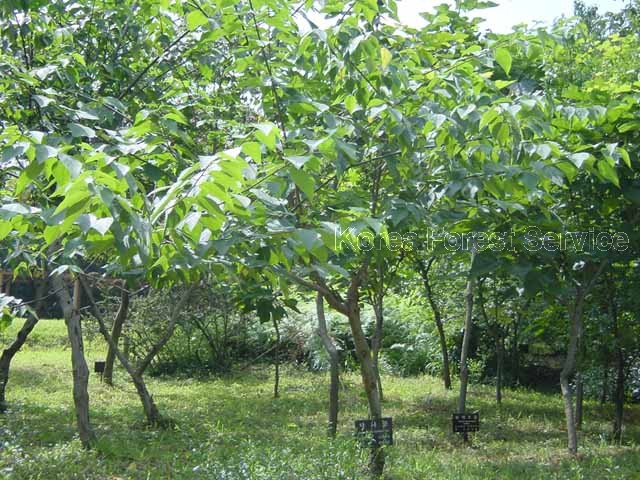- 글로벌메뉴
- KOREAN

 Korea Biodiversity Information System > Plant Resource > Plant Classification > Resource Plants > Fiber Resource
Korea Biodiversity Information System > Plant Resource > Plant Classification > Resource Plants > Fiber Resource
Fiber resources refer to plants whose fiber from bark, xylem, and lamina are used as materials for paper, fabric and rope. Although the demand for natural fiber has decreased dramatically following the introduction of chemical fiber, interest in natural fiber has recently increased because of its characteristics. Fiber resource plants are used not only for fabric but are also used widely by people for paper, nets, rope, and handicrafts.
While animal fiber is composed of protein, vegetable fiber is composed of cellulose and has very different physiochemical properties from that of animal fiber. Cotton is a typical example of a vegetable fiber, from which textiles are produced by using the fiber cells that wrap around cotton plant seeds. Both New World and the Old World species of cotton are used, which is different from other resource plants. Muslims who occupied Spain introduced cotton to Europe, and so the word muslin is said to be derived from Muslim. The production of cotton is low in comparison to the amount of agricultural chemicals, fertilizer and biomass used, and the fabric dye used for it causes serious environmental damage. Hemp is one of the oldest fiber resources used in Asia, has a very high productivity against total biomass due to its long fiber length, and has long been regarded as one of the five grains. The raw material of linen, flax, is another example of using plant fiber. Before the development of the fiber industry, linen was used more than cotton in Europe. Although the use of linen decreased significantly after the mass production of cotton, its use continues today. Ramie in Urticaceae is a fiber traditionally used in Korea. There are various other fiber resources, including Manila hemp collected from banana leaves; sisal, made with fibers from Agave, a desert plant; coir, made with coconut husk fibers; and jute, made from Moraceae.

Rush (Juncus effusus var. decipiens Buchenau) Juncaceae
Herbs, perennial, 50??100 ㎝ tall. Rhizomes creeping, with many short knots where long and slender green stalks in cylindrical shape come out. Stalks solid, leaves in scale pattern start from the base and wrap the stalks. Flowers green, in raceme, at the top of the stalk one by one in serial, bloom from May to July.

Paper mulberry (Broussonetia kazinoki Siebold) Moraceae
Shrub, deciduous, 200??500 ㎝ tall. Bark yellowish brown; twigs greenish brown with short hairs which fall soon. Leaves alternate, 5-20 ㎝ long, 3-9 ㎝ wide, ovate or long oval shaped, 2-3 lobed, dentate, apcies acute, base round to subcordate, surface rough.

Cotton (Gossypium indicum Lam.) Malvaceae
Flowers in August to September, solitary, axillary, with short peduncle, 4 ㎝ in diameter. Bracts 3, beneath the flower, leaflike, triangular ovate, purplish, dentate. Sepals cup shaped, with green dots; petals 5, imbricate.

Ramie (Boehmeria nivea (L.) Gaudich.) Urticaceae
Plants monoecious. Inflorescences panicles, axillary, drooping, shorter than petiole: Male inflorescences in lower part and female ones in upper part the stem, 5-10 ㎝ long. Male flowers yellowish white; perianth 4; stamens 4. Flowers in July to August.

Edgeworthia chrysantha Lindl (Edgeworthia chrysantha Lindl.) Thymeleaceae
Flower buds 1-2, develop at the end of branch in the fall, covered with caducous foliar bracts. Flowers yellow, drooping, in umbell at the end of branch, pedicels 1 ㎝ long, bloom in March before leaves come out.

Sponge Gourd (Luffa cylindrica Roem.) Cucurbitaceae
Plants monoecious. Male inflorescence raceme. Flowers yellow, bloom in August to September; female flowers solitary, corolla 5-10 ㎝ in diameter, 5-lobed, anthers free, ovaries 3-loculed, style 2 to 3-lobed.

Bulrush (Cyperus exaltatus var. iwasakii T.Koyama)
The flower blooms in 8~ September and from the leaf armpit I 1 run in kip flower stalk end and they are diameter 4㎝ husbands and wives. There are 3 parcels of the leaf pattern in the flower lower part and as the egg shape at the tripod they sleep and the light goes round and there is a saw tooth. The calyx of flower leaf the wine cup is same and green there is a point which sleeps and the petal is arrayed with 5 triumph luck lying in bed.

Arrowroot (Pueraria lobata (Willd.) Ohwi) Fabaceae
Inflorescence raceme, axillary, erect, 10-25 ㎝ long, with many pedicellate flowers. Flowers reddish purple, 1.8-2.5 ㎝ long, bloom in August; bracts linear, long hairy, 8-10 mm long, 1/4-1/3 mm wide, caducous. Bracteoles narrowly ovate or widely subulate.

Hemp (Cannabis sativa L.) Cannabaceae
Plants dioecious. Flowers light green, bloom in July to August. Male flowers in drooping panicle; sepals 5; stamen 5; anthers yellow, drooping, with copious pollens. Female flowers in short spike, subtended by a bracteole; ovary 1; styles 2.